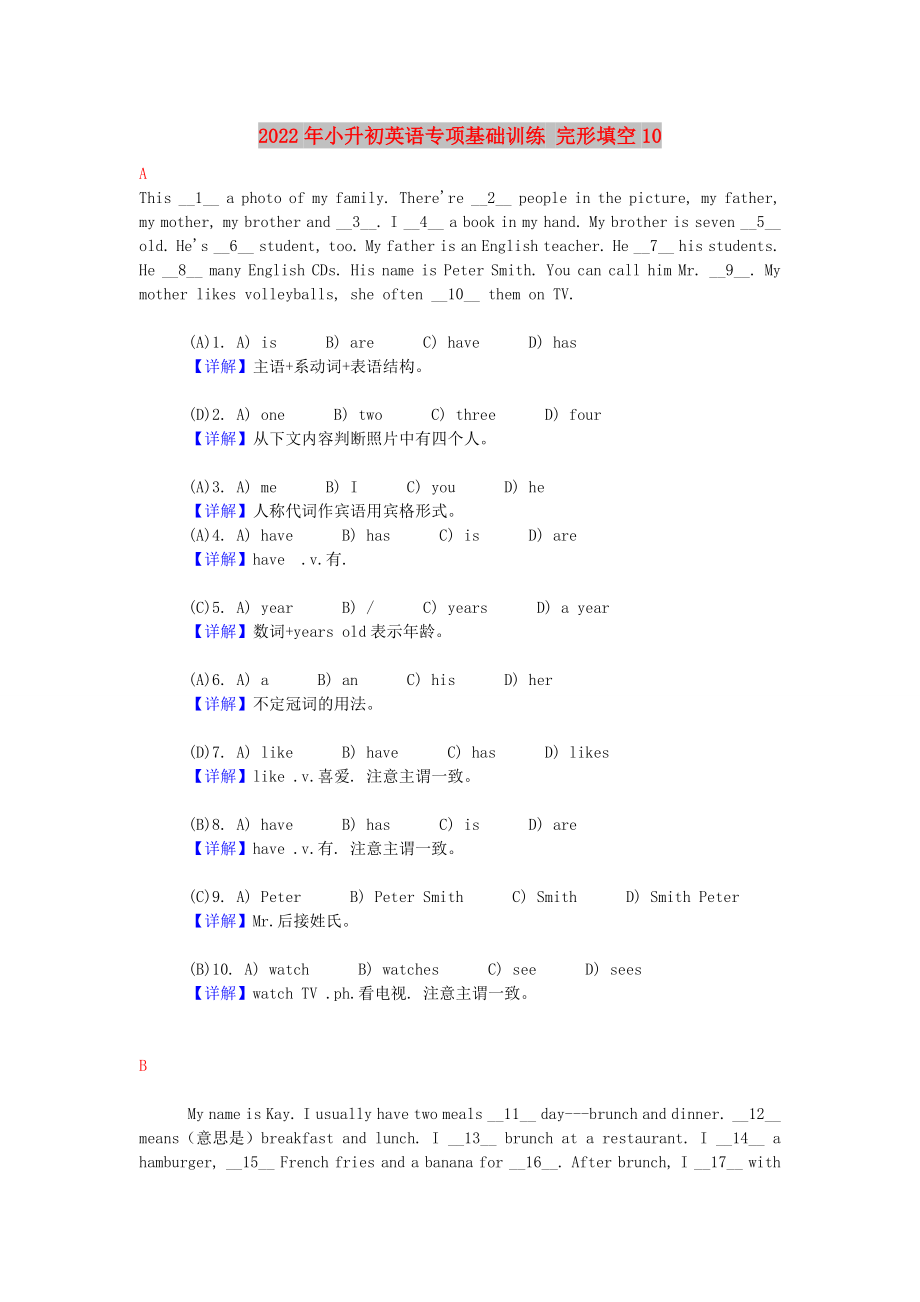《2022年小升初英語(yǔ)專(zhuān)項(xiàng)基礎(chǔ)訓(xùn)練 完形填空10》由會(huì)員分享,可在線閱讀���,更多相關(guān)《2022年小升初英語(yǔ)專(zhuān)項(xiàng)基礎(chǔ)訓(xùn)練 完形填空10(4頁(yè)珍藏版)》請(qǐng)?jiān)谘b配圖網(wǎng)上搜索��。
1、2022年小升初英語(yǔ)專(zhuān)項(xiàng)基礎(chǔ)訓(xùn)練 完形填空10
A
This __1__ a photo of my family. There're __2__ people in the picture, my father, my mother, my brother and __3__. I __4__ a book in my hand. My brother is seven __5__ old. He's __6__ student, too. My father is an English teacher. He __7__ his students. He __8__ many Engl
2����、ish CDs. His name is Peter Smith. You can call him Mr. __9__. My mother likes volleyballs, she often __10__ them on TV.
(A)1. A) is B) are C) have D) has
【詳解】主語(yǔ)+系動(dòng)詞+表語(yǔ)結(jié)構(gòu)。
(D)2. A) one B) two C) three D) four
【詳解】從下文內(nèi)容判斷照片中有四個(gè)人�。
3、
(A)3. A) me B) I C) you D) he
【詳解】人稱(chēng)代詞作賓語(yǔ)用賓格形式�。
(A)4. A) have B) has C) is D) are
【詳解】have .v.有.
(C)5. A) year B) / C) years D) a year
【詳解】數(shù)詞+years old表示年齡。
(A)6. A) a B) an
4����、C) his D) her
【詳解】不定冠詞的用法。
(D)7. A) like B) have C) has D) likes
【詳解】like .v.喜愛(ài). 注意主謂一致�����。
(B)8. A) have B) has C) is D) are
【詳解】have .v.有. 注意主謂一致�����。
(C)9. A) Peter B) Peter Smith C) Smith
5����、D) Smith Peter
【詳解】Mr.后接姓氏����。
(B)10. A) watch B) watches C) see D) sees
【詳解】watch TV .ph.看電視. 注意主謂一致�。
B
My name is Kay. I usually have two meals __11__ day---brunch and dinner. __12__ means(意思是)breakfast and lunch. I __13__ brunch at a re
6、staurant. I __14__ a hamburger, __15__ French fries and a banana for __16__. After brunch, I __17__ with my friends. And we have __18__ together. For dinner I like an __19__ and a tomato. After dinner I always have ice cream for __20__.
(A)11. A) a B) an C) one
【詳解】不定冠詞表
7���、示個(gè)數(shù)��,"day"以輔音音素開(kāi)頭���,所以用不定冠詞"a". two meals a day意思是“一天兩餐”。
(C)12. A) Meal B) Dinner C) Brunch
【詳解】根據(jù)前一句的提示和下文的解釋?zhuān)@里的主語(yǔ)應(yīng)為breakfast和lunch合成的一個(gè)單詞brunch.
(A)13. A) have B) has C) eats
【詳解】表示“吃飯”用動(dòng)詞have或eat. 這里主語(yǔ)是第一人稱(chēng)���,所以選擇have.
(B)
8���、14. A) am B) like C) has
【詳解】主語(yǔ)是第一人稱(chēng),根據(jù)主謂一致可排除has; 又因?yàn)椴豢赡苁?I am a hamburger", 所以選擇like, 意為“我喜歡……”��。
(C)15. A) a B) any C) some
【詳解】French fries是復(fù)數(shù)形式����,且在肯定句中�����,所以前面用some修飾�。
(B)16. A) one B) it C) them
【詳解】固定搭配have sth. for br
9��、eakfast/lunch/dinner. 在這里用it代替brunch.
(A)17. A) play B) bring C) eat
【詳解】play .v.玩耍�。句意為:飯后��,我和朋友一起玩�����。
(C)18. A) lunch B) breakfast C) dinner
【詳解】因?yàn)樯衔囊呀?jīng)提及"after brunch", 根據(jù)時(shí)間推移����,這里說(shuō)的吃飯指的是晚餐。而且下文中"for dinner"也有提示���。
(A)19. A) eg
10�����、g B) broccoli C) salad
【詳解】不定冠詞a用在以輔音音素開(kāi)頭的單詞前�����,an用在以元音音素開(kāi)頭的單詞前��。
(B)20. A) meal B) dessert C) drink
【詳解】dessert .n.甜點(diǎn)�。句意為:晚飯后,通常吃冰激凌作為甜點(diǎn)�。
附送:
2022年小升初英語(yǔ)專(zhuān)項(xiàng)基礎(chǔ)訓(xùn)練 完形填空11
A
A: I can't find my watch. __1__ it?
B: It's in your desk, I think.
11、 A: Let me see. Oh, no, it isn't in it.
B: Let's ask Wang Lei.
A: OK! Wang Lei, do you see my watch?
C: Oh, dear! Here are three watches in my bag. What color is yours?
A: It's black.
C: Good! __2__ you are.
A: Thank you very much.
C: That's __3_
12�、_. But, the red one is mine. __4__ is the brown one?
B: Let me have a look. Oh. It's Jim's.
C: Let's go and give it __5__ Jim.
A: OK! Let's go.
(A)1. A) Where B) Where's C) Where are D) Is
【詳解】特殊疑問(wèn)句詢(xún)問(wèn)地點(diǎn)用where, 意為:我的手表不見(jiàn)了,它在哪呢���?
(D)
13�����、2. A) It B) They C) There D) Here
【詳解】Here you are 固定用法����,表示“給你”����。
(D)3 A) right B) all C) it D) OK
【詳解】根據(jù)上文��,回答別人的感謝用That's OK. 表示“不用謝”����。
(A)4. A) Whose B) Who's C) Who D) What
【詳解】whose 詢(xún)問(wèn)“誰(shuí)的”��,意為:這個(gè)棕色的是誰(shuí)的呢�����?
14����、
(C)5. A) in B) on C) to D) of
【詳解】介詞to 表示對(duì)象���,意為:讓我們把它給Jim 吧�。
B
I have a good friend. __1__ name is Mary. She __2__ from America. Now she is __3__ China with her father and mother. She can __4__ much Chinese. She is in No. 15 Middle School i
15��、n Wuhan. Her father and mother are __5__. They teach in No. 50 Middle School. Mary is a __6__ student.
She __7__ up early. She doesn't __8__ to be late. So she goes to school very early. Today she goes to the classroom at 7:30 am. __9__ there aren't any students in the classroom. It is Satur
16���、day today. The students are at __10__.
(B)1. A) She B) Her C) His D) He
【詳解】根據(jù)后文知道Mary 是個(gè)女孩�����,因此用her, 表示“她的”�����。
(A)2. A) es B) are C) go D) e
【詳解】e from .ph.來(lái)自�;主語(yǔ)是單數(shù)第三人稱(chēng),故用es.
(B)3. A) on B) in C) at D)
17�����、of
【詳解】介詞in 表地點(diǎn)��,指“在……里面”�,in China 表示“在中國(guó)”。
(A)4. A) speak B) tell C) talk D) do
【詳解】會(huì)講某種語(yǔ)言用speak, 她很會(huì)講中文��。
(C)5. A) doctors B) doctor C) teachers D) teacher
【詳解】后文說(shuō)她的父母在50中教書(shū)�����,所以他們應(yīng)該是老師��,主謂都是復(fù)數(shù)���,因此用復(fù)數(shù)teachers.
18��、 (A)6. A) good B) bad C) boring D) interesting
【詳解】從下文看她每天起床很早��,不喜歡遲到�,說(shuō)明她是個(gè)好學(xué)生,good .adj.好的����。
(B)7. A) goes B) gets C) es D) needs
【詳解】get up .ph.起床,主語(yǔ)是單數(shù)第三人稱(chēng)��,故用gets.
(C)8. A) run B) eat C) like D) take
【詳解】like 表示“喜歡”��,這里指“她不喜歡遲到”��。
(C)9. A) So B) But C) When D) Where
【詳解】前文說(shuō)她今天很早就到校了����,但是教室里沒(méi)有人�����,這里用but 表示轉(zhuǎn)折����。
(B)10. A) school B) home C) class D) playground
【詳解】前文說(shuō)今天是星期六����,因此其他的同學(xué)應(yīng)該都在家里�����。
 2022年小升初英語(yǔ)專(zhuān)項(xiàng)基礎(chǔ)訓(xùn)練 完形填空10
2022年小升初英語(yǔ)專(zhuān)項(xiàng)基礎(chǔ)訓(xùn)練 完形填空10

